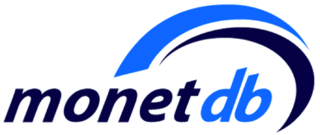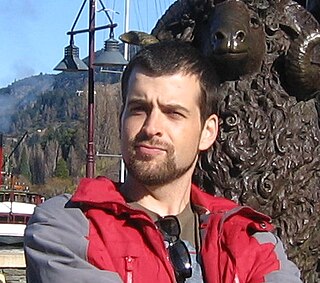
An object database or object-oriented database is a database management system in which information is represented in the form of objects as used in object-oriented programming. Object databases are different from relational databases which are table-oriented. A third type, object–relational databases, is a hybrid of both approaches. Object databases have been considered since the early 1980s.

PostgreSQL, also known as Postgres, is a free and open-source relational database management system (RDBMS) emphasizing extensibility and SQL compliance. PostgreSQL features transactions with atomicity, consistency, isolation, durability (ACID) properties, automatically updatable views, materialized views, triggers, foreign keys, and stored procedures. It is supported on all major operating systems, including Linux, FreeBSD, OpenBSD, macOS, and Windows, and handles a range of workloads from single machines to data warehouses or web services with many concurrent users.
Structured Query Language (SQL) is a domain-specific language used to manage data, especially in a relational database management system (RDBMS). It is particularly useful in handling structured data, i.e., data incorporating relations among entities and variables.

An object–relational database (ORD), or object–relational database management system (ORDBMS), is a database management system (DBMS) similar to a relational database, but with an object-oriented database model: objects, classes and inheritance are directly supported in database schemas and in the query language. In addition, just as with pure relational systems, it supports extension of the data model with custom data types and methods.

Ingres Database is a proprietary SQL relational database management system intended to support large commercial and government applications.
A database server is a server which uses a database application that provides database services to other computer programs or to computers, as defined by the client–server model. Database management systems (DBMSs) frequently provide database-server functionality, and some database management systems rely exclusively on the client–server model for database access.
The following tables compare general and technical information for a number of relational database management systems. Please see the individual products' articles for further information. Unless otherwise specified in footnotes, comparisons are based on the stable versions without any add-ons, extensions or external programs.

MonetDB is an open-source column-oriented relational database management system (RDBMS) originally developed at the Centrum Wiskunde & Informatica (CWI) in the Netherlands. It is designed to provide high performance on complex queries against large databases, such as combining tables with hundreds of columns and millions of rows. MonetDB has been applied in high-performance applications for online analytical processing, data mining, geographic information system (GIS), Resource Description Framework (RDF), text retrieval and sequence alignment processing.
In computing, GiST or Generalized Search Tree, is a data structure and API that can be used to build a variety of disk-based search trees. GiST is a generalization of the B+ tree, providing a concurrent and recoverable height-balanced search tree infrastructure without making any assumptions about the type of data being stored, or the queries being serviced. GiST can be used to easily implement a range of well-known indexes, including B+ trees, R-trees, hB-trees, RD-trees, and many others; it also allows for easy development of specialized indexes for new data types. It cannot be used directly to implement non-height-balanced trees such as quad trees or prefix trees (tries), though like prefix trees it does support compression, including lossy compression. GiST can be used for any data type that can be naturally ordered into a hierarchy of supersets. Not only is it extensible in terms of data type support and tree layout, it allows the extension writer to support any query predicates that they choose.
A spatial database is a general-purpose database that has been enhanced to include spatial data that represents objects defined in a geometric space, along with tools for querying and analyzing such data.
A column-oriented DBMS or columnar DBMS is a database management system (DBMS) that stores data tables by column rather than by row. Benefits include more efficient access to data when only querying a subset of columns, and more options for data compression. However, they are typically less efficient for inserting new data.

Illustra was a commercialized version of the Postgres object-relational database management system (DBMS) sold by Illustra Information Technologies, a company founded in 1992 and formed by Michael Stonebraker, Gary Morgenthaler and several of Michael Stonebraker's current and former students including: Wei Hong, Jeff Meredith, Michael Olson, Paula Hawthorn, Jeff Anton, Cimarron Taylor and Michael Ubell.

Joseph M. Hellerstein is an American professor of computer science at the University of California, Berkeley, where he works on database systems and computer networks. He co-founded Trifacta with Jeffrey Heer and Sean Kandel in 2012, which stemmed from their research project, Wrangler.

Samuel R. Madden is an American computer scientist specializing in database management systems. He is currently a professor of computer science at the Massachusetts Institute of Technology.
QUEL is a relational database query language, based on tuple relational calculus, with some similarities to SQL. It was created as a part of the Ingres DBMS effort at University of California, Berkeley, based on Codd's earlier suggested but not implemented Data Sub-Language ALPHA. QUEL was used for a short time in most products based on the freely available Ingres source code, most notably in an implementation called POSTQUEL supported by POSTGRES. As Oracle and DB2 gained market share in the early 1980s, most companies then supporting QUEL moved to SQL instead. QUEL continues to be available as a part of the Ingres DBMS, although no QUEL-specific language enhancements have been added for many years.
Informix Corporation was a software company located in Menlo Park, California. It was a developer of relational database software for computers using the Unix, Microsoft Windows, and Apple Macintosh operating systems.
NewSQL is a class of relational database management systems that seek to provide the scalability of NoSQL systems for online transaction processing (OLTP) workloads while maintaining the ACID guarantees of a traditional database system.

Martin L. Kersten was a computer scientist with research focus on database architectures, query optimization and their use in scientific databases. He was an architect of the MonetDB system, an open-source column store for data warehouses, online analytical processing (OLAP) and geographic information systems (GIS). He has been (co-) founder of several successful spin-offs of the Centrum Wiskunde & Informatica (CWI).

Eugene Wong is a Chinese-American computer scientist and mathematician. Wong's career has spanned academia, university administration, government and the private sector. Together with Michael Stonebraker and a group of scientists at IBM, Wong is credited with pioneering database research in the 1970s from which software developed by IBM, Microsoft, and Oracle descends. Wong retired in 1994, since then holding the title of Professor Emeritus of Electrical Engineering and Computer Sciences at University of California, Berkeley.
Daniel Abadi is the Darnell-Kanal Professor of Computer Science at University of Maryland, College Park. His primary area of research is database systems, with contributions to stream databases, distributed databases, graph databases, and column-store databases. He helped create C-Store, a column-oriented database, and HadoopDB, a hybrid of relational databases and Hadoop. Both database systems were commercialized by companies.









